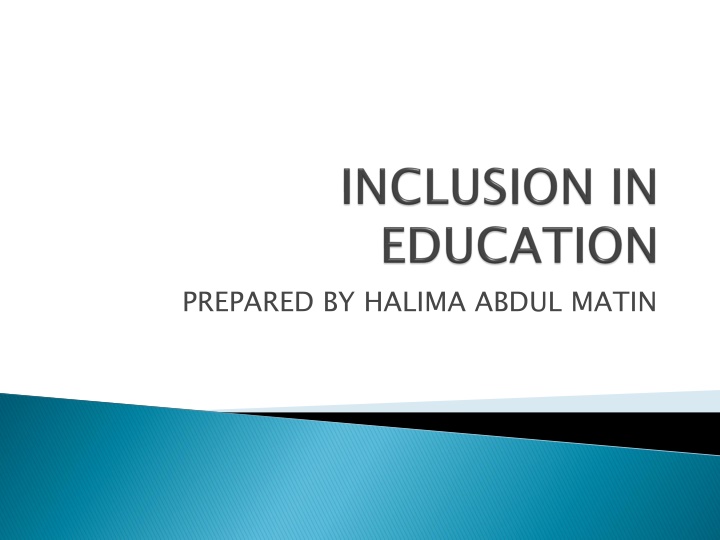
Embracing Inclusion in Education for All
Embrace the concept of inclusion in education to create a unified school system where all students can learn together without discrimination. Learn about the importance of providing quality education and rejecting special schools. Addressing differences, increasing participation, and fostering a sense of belonging are crucial aspects of this holistic approach to education.
Download Presentation

Please find below an Image/Link to download the presentation.
The content on the website is provided AS IS for your information and personal use only. It may not be sold, licensed, or shared on other websites without obtaining consent from the author. If you encounter any issues during the download, it is possible that the publisher has removed the file from their server.
You are allowed to download the files provided on this website for personal or commercial use, subject to the condition that they are used lawfully. All files are the property of their respective owners.
The content on the website is provided AS IS for your information and personal use only. It may not be sold, licensed, or shared on other websites without obtaining consent from the author.
E N D
Presentation Transcript
Inclusion means to take in. It is the opposite of exclusion, discrimination. Inclusion is about membership and belongingness. Inclusion is an all embracing societal ideology.
It is providing quality education . It refers to the placement and education of children with diverse needs in regular classroom.
Inclusion in education rejects the use of special schools or classroom. It is restructuring schools as the common place where they can learn without any discrimination. The ultimate goal for inclusion in education is to create a unified school system that serves all the students together.
A common educational community. Access to knowledge. A sense of belongingness. Increasing participation. Goal of equality. Addressing differences Revolutionary contrast to exclusion. Emphasises on the existing variations. Approach to remove barriers. It is social reform.
Holistic approach. Philosophy of collective membership.
No development is complete without inclusion. For development of education, for realizing its goal inclusion is needed. Inclusion is only possible if education is given without discrimination. Now the question is who are discriminated people?
The term disadvantaged is a generic term for individuals who face special physical or mental disability, who lack financial or economic support, who are politically deemed to be without sufficient power. Socially disadvantaged children are seen in interior tribal and rural areas of country where educational facilities have not reached yet.
SCHEDULE CASTE- The schedule caste were called by various names like chandals . Majority of SC have been regarded as untouchables . Under the government of India Act 1935 the untouchables are designated as Schedule Caste.
The personalities like Gandhiji, Dr. Ambedkars effort towards removal of untouchability was significant. As a result Article 17 of the constitution of India abolished untouchability. Mahatma Gandhi defined SC as Harijans- the people of God
The term tribe means simple folk living in hills and forests. Gandhiji called them Girijans. Gillin and Gillin defines- a tribe is a group of local communities which lives in a common area, speaks a common dialect and follows a common culture.
The children belonging to these group show poor academic performance of high drop out rates. They also have adjustment problems. They have deficiencies in the two most important skills reading and language. This is the factor of high drop outs. Cultural or social deprivation creates a complex set of condition which again give rise to intellectual deficiency in the children.
Constitution of India guarantees special educational and other measures for these group. Article 46- THE STATE SHALL PROMOTE, WITH SPECIAL CARE, THE EDUCATION AND ECONOMICI INTEREST OF THE WEAKER SECTION OF THE PEOPLE, IN PARTICULAR OF THE SC AND ST AND SHALL PROTECT THEM FROM SOCIAL INJUSTICE AND ALL FORMS OF SOCIAL EXPLOITATION.
It is important that Article 330, 332, 335, 338 to 342 and the entire Fifth and Sixth schedules of the constitution deal with special provisions for implementation of the objectives set in Article 46. Article 15(4) provides special provision for the advancement of any socially and educationally backward class.
A relaxed norms for opening of primary/middle schools. Abolition of tuition fees. Providing incentives- free text book.... Free and compulsory elementary education. SSA- Useful quality education to all children in the 6-14 age group by 2010 DPEP is a scheme, the thrust of which is on disadvantaged group.
Establishment of schools with minimum norms of infrastructure. Establishment of norms of behaviour. provision of escort. Encouragement of co-curricular activities. Increasing and encouraging the interaction and participation. Avoiding segregation in the classroom. Opening school or centre of education in the SC concentrated neighbourhood.
Provision of monitoring the attendance and retention SC/ST. Provision of scholarship. Provision of special facility residential schools or transport. Sensitisation of teachers to SC/ST culture. Provision of free text book. Encouragement of involvement of community members in the school activities to reduce social distance.
To address disadvantages and diversity. To cater the needs of every child. To sensitise the teacher to the issues of social disadvantages. To remove the stigma of disadvantages. To remove the sense of inferiority. To show low social and psychological strain. To remove high sense of avoidance for failure. To reduce drop-out rates. To remove the social barriers to meaningful participation in schools.
